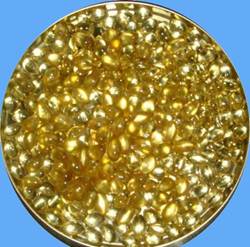BY-PRODUCTS
Fishes are consumed as food in fresh condition. Some of them are also utilized after the preservation. During preservation and processing, some materials of fish and prawn are discarded as waste. Similarly some trash and distasteful fishes are unsuitable for human consumption. These waste material and above fishes become an important source to produce fish by-products, which in turn are used to produce different useful fish by-products.
Fish flesh on an average contains 15-20 per cent protein. Some species of fish contain very high amounts of body oil. Few species of fish like shark, cod etc. are good sources of liver oil. Fish processing and filleting industries turn out large quantities of fishery waste. All these are good sources of high quality protein, fat, minerals etc.
The traditional fishery byproducts are fishmeal, fish body and liver oils, fish maw, isinglass etc. Fish protein concentrate, fish albumin, glue, gelatin, pearl essence, peptones, amino acids, protamines, fish skin leather etc. are some other byproducts generally processed out of fish and fish waste. Chitin and chitosan processed out of shrimp, crab and other crustacean waste are byproducts of high economic value. Biochemical and pharmaceutical products like bile salts, insulin, glucosamine etc. are some other fishery byproducts of great significance. A brief account of some of the important fishery byproducts is given below.
1. GELATIN
Gelatin is a protein that lacks in an essential amino acid tryptophan, and hence cannot be considered as a sole source of protein in animal or human nutrition. But it is a relatively high source of lysine and methionine, which are deficient in cereal proteins. However, gelatin finds extensive use in food as also in the formulation of some industrial products. Gelatin can be extracted from the skin and bones of fish.
Uses :
Gelatin is used in the food industry as a gelling, stabilising, emulsifying, dispersing or thickening agent.
2. INSULIN
Insulin is a hormone used for correcting the condition called diabetes mellitus in humans. Fish insulin is more stable as it is not subjected to decomposition by protein splitting enzymes of pancreas.
3. FISH ALBUMIN
Fish albumin is a product similar to egg albumin in physical and chemical properties. It can be processed out of proteinaceous residue from fish scrap or fish waste. Two grades of fish albumin are produced, the technical grade and the food and pharmaceutical grade.
Uses
Fish albumin is widely used in food and pharmaceutical products as whipping, suspending or stabilizing agent. Food grade albumin is an additive in ice cream, soup powder, puddings, confectionery, bakery products, mayonnaise, custard powder etc.
4. FISH PROTEIN CONCENTRATE
Fish protein concentrate (FPC) is a stable protein concentrate prepared from whole fish or other aquatic animals or parts thereof. Protein concentration is increased by removal of water, oil, bones and other materials. Traditionally dried or otherwise preserved products do not fall within this definition. Development of FPC has paved the way for converting a wide range of whole fish into protein concentrate, which has no resemblance to the original raw material, for human nutrition.
Proximate composition
Fish Protein Concentrate is a gritty, colourless, odourless and tasteless powder. It is stable up to 3-4 years at room temperature without any significant change in flavour. Proximate composition of a representative sample of FPC is given below:
The greater quantity of highly digestible protein, available lysine and minerals makes FPC a highly nutritious product.
Uses
Though FPC is intended for human consumption it is not relished for consumption as such. It is therefore incorporated as a protein supplement in human diet. 5-10 per cent level FPC in bread and biscuit is considered the acceptable limit. 35 g per person per day is a recommended level of use of FPC.
5. SHARK FIN RAYS
- Shark fin ray is a valuable byproduct from the shark.
- The shark fins are dried, soaked overnight in 10% acetic acid solution.
- The skin and the softened muscle are scraped off and the rays are separated individually.
- They are then washed thoroughly and dried.
- Shark fin rays are an essential ingredient in some exotic soups.
|
 |
6. Chitin and Chitosan
- Chitin is the second most abundant biopolymer on earth next only to cellulose.
- It is a white, hard, inelastic nitrogenous polysaccharide extensively used for several purposes.
- In India, the single largest source of chitin is the shrimp shell and head waste.
- Chitin is produced from the shell waste by deproteinisation and demineralization.
- Chitosan is produced by the deacetylation of chitin.
- Chitosan has several industrial and medicinal uses.
|
 |
7. Squalene
- Squalene is a highly unsaturated hydrocarbon present in the liver oil of certain species of deep sea sharks mainly Centrophorus and Squalidae spp.
- The liver oil of these species contain high percentage of squalene (90%) which can be isolated and purified and can be used as a dietary supplement.
|
 |
8. Isinglass
- Isinglass is prepared from fish maws (dried air bladder).
- Fish maws is soaked in water for 24 hours, washed and extruded, dried at 450 c and then powdered. It is mainly used for the clarification of wines.
|
 |
9. Collagen-Chitosan Membrane for Plastic Surgery and Dentistry
R&D for biomedical applications is a mandatory activity of CIFT. Understanding the utility of collagen as a connective tissue owing to its tensile strength, CIFT has done pioneering work in fish collagen and development of a technology for sutures from fish gut was a breakthough in the field which is under the process of patenting.
The recent success achieved by Dr M.K.Mukundan and his associates in the Biochemistry and Nutrition Division in developing a collagen chitosan membrane from the collagen of fish air bladder and chitosan from prawn shell is very well received by the medicos, as the trials done at the Calicut Medical College in Kerala have shown that this absorbable membrane, is excellent ?artificial skin? in cases of severe burns/wounds preventing infection and loss of body fluids/ blood. It finds extensive use in dental surgery also as a material for guided tissue regeneration. Dental surgery at present, uses costly imported teflon membrane. The membrane is being patented and is also taken up on consultancy by three biomedical firms. |
 |
MINCE AND MINCE-BASED PRODUCTS
Fish mince or minced fish is the flesh separated from the fish in a comminuted form free from scales, skin and bones. Trimmings from the fish filleting operations, whether hand or machine filleting, was the original source of fish mince. Significant value addition will accrue to such fish if converted into fish mince because mince can be used to process a variety of value added products having high commercial potential. Another advantage of the process is that it conceals identity of the original fish from which it is made and consumers may not hesitate to accept mince or mince based products even though the original fish would have been unacceptable as whole fish.
|
Production of fish mince
Mince can be prepared either from gutted fish or whole fish. Mince from gutted fish will be better in colour, appearance and flavour. For best quality minces it is desirable to use only a single species of fish so that mince of different quality and stability do not mix together.
The freshness of the raw material profoundly influences the quality of the mince. The mince will contain all the components like the enzymes, lipids, haem pigments etc. in the fish that affect its shelf stability. The mince is frozen and stored.
Mince-Based Products
The fish mince finds application in processing several convenience foods like fish finger, cutlet, burger and also in some low cost salted and dried products. In preparation of fish finger, stick, sake etc., the mince stripped from the bone frame is incorporated to increase the yield.
Surimi
Surimi is a Japanese term for mechanically deboned fish flesh that has been washed with water and mixed with cryoprotectants for good frozen shelf life. Washing not only removes fat and undesirable matters such as blood, pigments and odoriferous substances but also increases the concentration of myofibrillar protein, the content of which improves the gel strength and elasticity of the product. This property can be made use of in developing a variety of fabricated products like shellfish analogues.
Method of production
Meat is separated using a meat-bone separator. The diameter of perforations in the drum should not be larger than 3-4 mm to prevent the skin and scales from passing through the holes.
The minced fish is washed repeatedly with chilled water (5-10°C) until most of the water soluble protein is removed. Usually 5-10 times water is used and three washings employed. In the final washing, 0.01-0.3% sodium chloride is used to ease the removal of water and pressed using a screw press to a moisture level of 78-80%. Using a silent cutter, cryoprotectants like sugar, sorbitol and polyphosphates are mixed into the dewatered fish meat at levels 4, 4 and 0.2% respectively. During the process the temperature is not allowed to exceed 10°C above which the protein functionally could be damaged.
The total protein lost during the washing process is approximately 30% of the minced meat and depends on the amount of water used and number of washing cycles employed.
Kneaded products
Several kneaded products like kamaboko, chikuwa, hampen, fish ham and sausage are processed using surimi incorporating other ingredients. The ingredients used in most of these preparations are identical; however, the classification is principally based on the manufacturing process involved. The ingredients employed other than surimi include salt, monosodium glutamate, sugar, starch, egg white, polyphosphate and water. The method of processing all these products involves grinding together of the various ingredients to a fine paste and some sort of heat treatment at some stage.
Fibreized products
Fibreized products are the greatest in demand among the surimi based imitation shellfish products. The ingredients used in the formulation of fibreized products includes, besides surimi, salt, starch, egg white, shellfish flavour, flavour enhancers and water. All the ingredients are thoroughly mixed and is ground to a paste. The paste is extruded in sheet on the conveyor belt and is heat treated using gas and steam for partial setting. A strip cutter subdivides the cooled sheet into strings and is passed through a rope corner. The rope is coloured and shaped. The final product is formed by steam cooking the coloured and shaped material.
Fish cutlets
Fish cutlets are prepared using cooked fish mince, which is mixed with cooked potato, fried onion and species etc. It is then formed into the desired shape, each weighing approx. 40 g. The formed cutlets are battered, breaded and flash fried for 20 seconds
Fish finger
Fish finger is a very popular product made out of fish mince. The mince is mixed with 1.0 per cent salt, made into rectangular slabs and frozen. The frozen mince is cut into suitable uniform sizes. These pieces are given a coating of batter followed by breading. The battered and breaded fish fingers are flash-fried in oil maintained at 180-200° C for about 20 seconds. After cooling the fingers are frozen and stored.
|
(Source: http://bieap.gov.in/capturefisheriesandpostharvesttechnology.pdf)
http://www.cift.res.in/innercontent.php?contentid=Mjg5 |





